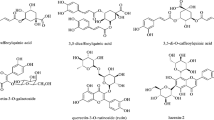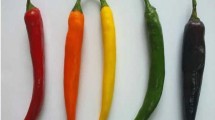Abstract
Methanol extracts from the placenta, stalk, and pricarp of 5 Korean varieties red pepper (Capsicum annuum L) were obtained and antioxidant constituents including total phenol, total flavonoids, and capsaicin were analyzed. Antioxidant effects were determined by ABTS, DPPH, and nitric oxide (NO) free radicals scavenging activities and superoxide dismutase (SOD)-like activity. All the extracts showed strong antioxidant activities in various bioassays. Chromatic parameters (L*, a*, b*, C*, and Ho) were responsible for the antioxidant capacity of red pepper pericarp extracts. Generally, stalk been considered as disposable part, exhibited not only strong scavenging activities against free radicals, but also high content of total phenols, total flavonoids, and capsaicin. In addition, positive correlations were also observed between antioxidant activities and constituents of phenolics, flavonoids, and capsaicin. It was concluded that red pepper, including stalk, can be functional food materials to enhance human health.
Similar content being viewed by others
References
Lee Y, Howard LR, Villalon B. Flavonoids and antioxidant activity of fresh pepper (Capsicum annuum) cultivars. J. Food. Sci. 60: 473–476 (1995)
Chuah AM, Lee YC, Yamaguchi T, Takamura H, Yin LJ, Matob T. Effect of cooking on the antioxidant properties of colored peppers. J. Food Chem. 111: 20–28 (2008)
Ahn J, Grcun IU, Fernando LN. Antioxidant properties of natural plant extract containing polyphenolic compounds in cooked ground beef. J. Food Sci. 67: 1364–1369 (2002)
Botsoglou NA, Christaki E, Fletouris DJ, Florou-Paneri P, Spais AB. The effect of dietary oregano essential oil on lipid oxidation in raw and cooked chicken during refrigerated storage. Meat Sci. 62: 259–265 (2002)
Kwon MJ, Song YS, Song Y. Antioxidative effect of kimchi ingredients on rabbits fed cholesterol diet. J. Korean Soc. Food Sci. Nutr. 27: 1189–1196 (1998)
Miller NJ, Rice-Evans CA. Factors influencing the antioxidant activity determined by the ABTS+ radical cation assay. Free Radical Res. 26: 195–199 (1997)
Brand-Williams W, Cuvelier ME, Berset C. Use of free radical method to evaluate antioxidant activity. LWT-Food Sci. Technol. 28: 25–30 (1995)
Gil MI, Tomas-Barberan FA, Hess-Pierce B, Kader AA. Antioxidant capacities, phenolic compounds, carotenoids, and vitamin C contents of nectarine, peach, and plum cultivars from California. J. Agr. Food Chem. 50: 4976–4982 (2002)
Ku KM, Kim HS, Kim BS, Kang YH. Antioxidant activites and antioxidant constituents of pepper leaves from various cultivars and correlation between antioxidant activities and antioxidant constituents. J. Appl. Biol. Chem. 52: 70–76 (2009)
Ku KM, Kim MG, Hong MJ, Jeong YS, Kim JS, Lee IJ, Shin DH, Hwang YH, Kang YH. Antioxidant and QR inductive activities of novel functional soybean ‘Agakong3’. Food Sci. Biotechnol. 18: 624–629 (2009)
Re R, Pellegrini N, Proteggente A, Pannala A, Yang M. Antioxidant activity applying an improved ABTS radical cation decolorization assay. Free Radical Bio. Med. 26: 1231–1237 (1999)
Lee YU, Huang GW, Liang ZC, Mau JL. Antioxidant properties of three extract from Pleurotus citrinopileatus. LWT-Food Sci. Technol. 40: 823–833 (2007)
Kim SM, Cho YS, Sung SK. The antioxidant ability and nitrite scavenging ability of plant extracts. Korean J. Food Sci. Technol. 33: 626–632 (1996)
Bredt DS, Snyder SH. Nitric oxide: A physiologic messenger molecule. Annu. Rev. Biochem. 63: 175–195 (1994)
Shibuki K, Okada D. Endogenous nitric oxide release required for long-term synaptic depression in the cerebellum. Nature 349: 326–328 (1991)
Snezana MM, Aleksandar ND, Nebojsa LA, Silvana AA, Tatjana SK, Gordana MB, Mirjana B. Nitric oxide-scavenging activity of polyhydroxylated fullerenol, C60(OH)24. Biol. Chem. 11: 201–207 (2004)
Maria I, Francisco A, Barbwra N, Betty HP, Adel AK. Antioxidant capacities, phenolic compounds, carotenoids, and vitamin C contents of nectarine, peach, and plum cultivars from California. J. Food Chem. 50: 4976–4982 (2002)
Um HJ, Kim GH. Studies on the flavonoid compositions of Elsholtzia spp. Korran J. Food Nutr. 20: 103–107 (2007)
Barbero GF, Liazid A, Palma M, Barroso CG. Fast determination of capsaicinoids from peppers by high-performance liquid chromatography using a reversed phase monolithic column. J. Food Chem. 107: 1276–1282 (2008)
Curl AL. The carotenoids of red bell pepper. J. Agr. Food Chem. 10: 504–509 (1962)
Davies BH, Susan M, Kirk JTO. The nature and biosynthesis of the carotenoids of different color varieties of Capsicum annuum. Phytochemistry 9: 797–805 (1970)
Miranda M, Maureira H, Rodriguez K, Vega-Gálvez A. Influence of temperature on the drying kinetics, physicochemical properties, and antioxidant capacity of aloe vera (Aloe Barbadensis Miller) gel. J. Food Eng. 91: 297–304 (2009)
Sigge GO, Hansmanw CF, Joubert E. Effect of storage conditions, packaging material, and metabisulphite treatment on the color of dehydrated green bell peppers (Capsicum annuum L.). J. Food Quality 24: 205–218 (2001)
Ramakrishnan TV, Francis FJ. Color and carotenoid changes in heated paprika. J. Food Sci. 38: 25–28 (1973)
Hagerman AE, Riedl KM, Jones GA, Sovik KN, Ritchard NT, Hartzfeld PW. High molecular weight plant polyphenolics (tannins) as biological antioxidants. J. Agr. Food Chem. 46: 1887–1892 (1998)
Huang D, Ou B, Prior RL. The chemistry behind antioxidant capacity assays. J. Agr. Food Chem. 53: 1841–1856 (2005)
Bondet V, Brand-Williams W, Berset C. Kinetics and mechanism of antioxidant activity using the DPPH free radical method. LWT-Food Sci. Technol. 30: 609–615 (1997)
Deepa N, Kaura C, George B, Singh B, Kapoor H. Antioxidant constituents in some sweet pepper (Capsicum annuum L.) genotypes during maturity. J. Food Sci. Technol. 40: 121–129 (2007)
Kim HK, Na GM, Ye SU, Han HS. Extraction characteristics and antioxidative activity of Schiznadra chonenesis extracts. Korean J. Food Culture 19: 484–490 (2004)
Sim KY, Sil HY. Antioxidant activities of red pepper (Capsicum annuum) pericarp and seed extracts. Int. J. Food Sci. Tech. 43: 1813–1823 (2008)
Acker SA, Tromp MN, Haenen GR, Bast A. Flavonoids as scavengers of nitric oxide radical. Biochem. Bioph. Res. Co. 214: 755–759 (1995)
Yaowared S, Yukihisa M, Michihisa T, Opa V, Kinzo M, Hiroshi W. Evaluation of the nitric oxide radical scavenging activity of manganese complexes of curcumin and its derivative. Biol. Pharm. Bull. 27: 170–173 (2004)
Marin A, Ferreres F, Tomás-barberaán FA, Gil MI. Characterization and quantitation of antioxidant constituents of sweet pepper (Capsicum annuum, L.). J. Agr. Food Chem. 52: 3861–3869 (2004)
Howard LR, Talcott ST, Brenes CH, Villalon B. Changes in phytochemical and antioxidant activity of selected pepper cultivars (Capsicum species) as influenced by maturity. J. Agr. Food Chem. 48: 1713–1720 (2000)
Peterson J, Dwyer J. Taxonomic classification helps identify flavonoid-containing foods on a semiquantitative food frequency questionnaire. J. Am. Dietetic Assoc. 98: 677–685 (1998)
Olga CP, Luis WT, Carlos G, Fernando CM, Tomas GE, Sergio RP. Capsaicinoids quantification in chili peppers cultivated in the state of Yucatan, Mexico. J. Food Chem. 104: 1755–1760 (2007)
Shela G, Milena C, Ivana M. Characterization of antioxidant compounds in Jaffa sweeties and white grapefruits. J. Food Chem. 84: 503–510 (2004)
Author information
Authors and Affiliations
Corresponding author
Rights and permissions
About this article
Cite this article
Chen, L., Hwang, JE., Gu, K.M. et al. Comparative study of antioxidant effects of five Korean varieties red pepper (Capsicum annuum L) extracts from various parts including placenta, stalk, and pericarp. Food Sci Biotechnol 21, 715–721 (2012). https://doi.org/10.1007/s10068-012-0093-2
Received:
Revised:
Accepted:
Published:
Issue Date:
DOI: https://doi.org/10.1007/s10068-012-0093-2




